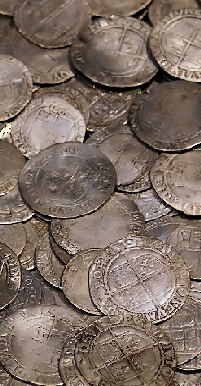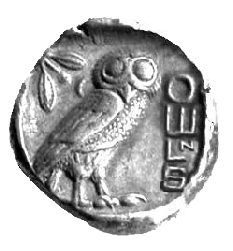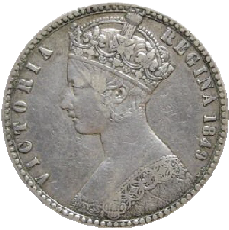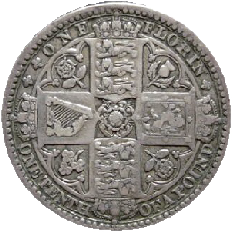
● Next Meeting Status:
Cancelled



● Host Society for the
BANS 2011 Congress
held in Southport


Decimall Arithmeticke
This short paper was offered to the Society in 2006 to commemorate the 158th anniversary of the decimalisation of the British coinage, though in true British fashion decimalisation was a case of “I’ve started, but I won’t finish just yet.”

Great Britain was very nearly the last country to adopt a fully decimal currency, though as we all know, elements of it have been decimal since the introduction of the Florin, carefully labelled “one tenth of a pound” in 1849. There was an enormous fuss and bother in the years leading up to 1971, though in real terms the only difference was that as the value of the penny got bigger, the size of the coin got smaller. Once you had accepted the fact that less is more, everything else followed naturally.
Needless to say, there had been an extensive series of studies, focus groups, discussion fora, committees and commissions, and consultation before the final changes were introduced in 1971.
In 1608, Robert Norton translated a famous Dutch work by Simon Stevin: Disme: the Art of Tenths, or, Decimall Arithmeticke which proposed that the currency should be divided into decimal fractions. The idea was taken further in 1619 when Henry Lyte published a book with an almost identical title which additionally proposed that decimal currency should be linked with decimal weights and measures.
By 1682, there was an almost irresistible demand that “something should be done.” Sir William Petty put forward a suggestion that there should be five farthings to a penny, instead of four, so that we could “keep all accompts in a way of Decimal Arithmetic, which hath been long desired for the ease and convenience of Accompting.” Unfortunately, he chose to give the name "Quantalumcunque" to his publication, which undoubtedly ensured that it never faded away from exposure to the light of day.

The Great Recoinage of 1696/7 would, you might think, have given the decimalists a wonderful opportunity to work their ways and, indeed, their lack of success was not for the want of trying. An anonymous broadsheet of 1695 entituled (lovely word, that!) "A letter from London to a Friend in Westminster, proposing some Particulars relating in the Coyn" suggested that a “William Royal” should form the tenth part of a pound, a “Ropee” should form the hundredth part, and a farthing should be the thousandth part. This was apparently the first time that a proposal envisaged a thousand minor units to the pound, but certainly not the last.
Unfortunately the Americans beat us to it. Much quicker off the mark, they introduced a decimal system for their new currency in 1792 in order to make it as different as possible to the colonial pounds, shillings and pence. So they chose the equally colonial Spanish dollar as their major unit. The Americans did, however, introduce one new feature to decimal currency which we, in due course, were to slavishly adopt: the half cent. It has to be said, though, that not all Americans were committed decimalists: the State of Massachusetts only got round to abolishing the shilling as legal tender in 1948.
The perfidious French went next. They used to have a sensible, logical, currency system: 12 deniers equalled one sol, and twenty sols equalled one livre. Now, what could be more straight forward than that? It even had the right abbreviations, LSD. Then came the revolution and, as with all revolutions, it had to be revolutionary. So out went LSD and in came centimes, decimes and francs. All quite simple, really, one sol became five centimes and twenty of them became one franc instead of one livre.
This must have been a good idea, because in the period up to 1815, a surprisingly large number of European countries adopted the same standard. Either it was a good idea, or the presence of a large contingent of French troops bivouacked in the local Treasury concentrated the minds of these various Governments.

Having missed the opportunity with the Great Recoinage of 1696/7, our decimalists
only had to wait until the Great Recoinage of 1816/7 for their next chance to get
in on the ground floor, so to speak. Mr J Wilson Croker expressed the view, in the
House of Commons, that “it would be almost unpardonable for the legislature at this
time to re-
The decimalists didn’t give up, though, and it was only another eight years before
someone else had a go. Sir John Wrottesley introduced a motion in the Commons to
“inquire how far the coin of the realm could be adapted to a decimal scale.” Sir
John wanted the pound to be divided into ten double-
By 1832 the computer boffin and IT whizkid Charles Babbage had climbed onto the decimal bandwagon, recommending change in his book On the Economy of Machinery and Manufactures but this was obviously of much too much practical use to be practical.
It was left to a future Governor of Hong Kong, Sir John Bowring – was the governorship a reward or a punishment, one wonders – to make the final move. In 1847 he proposed that there should be a new coin, the Queen, at ten to the pound, and another new coin, the Victoria, at one hundred to the pound. The patriotic argument obviously won the day, and the Chancellor agreed to introduce decimal currency “gradually.” The Queen was introduced in 1849, though rechristened “One Florin, One Tenth of a Pound” with the aim that at the very worst it could do no harm, and that “the present system could go on if that failed.”

But as we know, it didn’t fail, and the second part of the change was introduced, on schedule, only 122 years later, once the population had become used to the new coin.
Chris Leather



Where to next?
